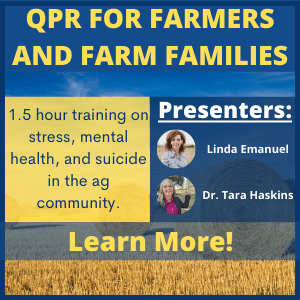Last updated on July 19th, 2024 at 10:24 am
Pesticide and Chemical Safety Resources
Agricultural chemicals refer to any substance involved in the growth or utilization of any plant or animal of economic importance.
Chemicals on the farm can be dangerous. Common chemicals include pesticides fuels, cleaners and solvents, and veterinary chemicals. Treat all chemicals with extreme caution and only ever used according to the instructions.
A pesticide is a substance or mix of substances intended to prevent or destroy pests. These include herbicides, insecticides, and fungicides. Any exposure to pesticides, regardless of the amount or duration, can result in poisoning as well as short-term and long-term health challenges. Pesticide exposure can occur through ingestion (through the mouth), inhalation (through breathing), or absorption (through skin contact). Common health effects include headaches, blurred vision, cancer, burns to skin/eyes/throat/face, nervous system involvement, and birth defects.
Children and pregnant women are uniquely vulnerable to toxic side-effects from pesticide exposure. Chemicals used to clean dairy facilities and equipment, especially dairy pipeline cleaners, pose a special risk for children.
It is important to read all chemical labels completely, and to then follow the directions for use, wear the relevant protective equipment, and to store, clean, and dispose of the chemicals properly. When storing chemicals, make sure they are all properly labelled, kept in their original containers, and stored in a safe area that is dry and shaded. Protective equipment might include goggles, chemical gloves, chemical aprons, respiratory protection like masks, proper footwear, long pants, and shirts with long sleeves. Leather shoes and boots can absorb chemicals, so make sure to wear neoprene or PVC boots when spraying liquids.
Following the use of any chemicals, it is necessary to wash hands and other exposed skin with soap and water and dry carefully. Clothes and footwear exposed to chemicals should not be worn in the home or laundered with family clothing.
Although farming is still a largely family operated business, OSHA does have standards for enforcement (OSHA 29 CFR 1928) and regulations which are applicable to employers with more than 10 employees. In some cases, the General Duty clause will be called into effect as a safe management practice if the hazard is not covered in the Agricultural Standard or the General Industry Standard. The EPA Agricultural Worker Protection Standard is an excellent guide to use of chemicals and guidance in development of a chemical protection program for agricultural operations.
Pesticide and Chemical Safety Resources
Articles and Blog Posts
- Chemical Pesticides and Human Health: The Urgent Need for a New Concept in Agriculture
- Pesticide Exposure and Child Neurodevelopment
- Why Do They Do That? Farmers Applying Chemicals
Resource Library
| ID | Title | Summary | Link |
|---|---|---|---|
| 10358 | Anhydrous Ammonia | episode of Talking Total Farmer Health | |
| 12096 | Anhydrous Ammonia Safety Tips for Farmworkers | Learn how to use Anhydrous Ammonia safely when doing farm work. | |
| 15249 | Best Practices in the Detection and Monitoring of Pesticide Exposure | Farmers and agricultural workers are routinely exposed to a wide variety of chemicals. Toxicity Category I and II organophosphates (OPs) and N-methyl carbamates are cholinesterase-inhibiting insecticides commonly used in agriculture to kill insects or prevent them from damaging or destroying crops. Over-exposure to these chemicals results in the inhibition of the enzyme cholinesterase (ChE) which is utilized in the body’s conducting tissue, such as nerve and muscle motor sensory fibers. Acute toxic effects can include confusion, headache, and even loss of consciousness. Severe inhibition of ChE in the body can result in muscle paralysis, respiratory failure, seizures, coma, and death. Currently, there is no practice standard or national medical surveillance program for cholinesterase monitoring. | |
| 8903 | Cholinesterase Testing Protocols for Healthcare Providers | Cholinesterase testing protocols for healthcare providers. Includes Cholinesterase Testing Protocol Algorithm. | |
| 12787 | Consejos de Seguridad para Agricultores sobre Gas Amoniaco (NH3) | Spanish language guide on how to use Anhydrous Ammonia safely when doing farm work. | |
| 9864 | Dress for Success: Some Things to Know About Personal Protective Equipment BEFORE You Handle a Pesticide | Syngenta has collaborated with the Canadian Agricultural Safety Association to create Dress for Success!, a resource for farm employers and employees regarding basic PPE principles and practices to protect the health and safety of everyone involved in handling a pesticide. | |
| 9865 | How to Comply with the 2015 Revised Worker Protection Standard for Agricultural Pesticides: What Owners and Employers Need to Know | EPA in conjunction with the Pesticide Educational Resources Collaborative (PERC) is making available a guide to help users of agricultural pesticides comply with the requirements of the 2015 revised federal Worker Protection Standard. You should read this manual if you employ agricultural workers or handlers, are involved in the production of agricultural plants as an owner/manager of an agricultural establishment or a commercial (for-hire) pesticide handling establishment, or work as a crop advisor. | |
| 8000 | Personal Protective Equipment: OSHA Guidance | This OSHA publication provides a general overview of personal protective equipment requirements and selection. | |
| 9395 | Pesticide Storage Concerns During and After a Flood | A resource about immediate actions to take after a storm when floodwaters or a storage facility could potentially be contaminated with pesticide. | |
| 8905 | Recognition and Management of Pesticide Poisonings | The purpose of this manual is to provide healthcare professionals with current consensus recommendations for treating patients with pesticide-related illnesses or injuries. | |
| 11964 | What is Safety? Chemicals | “What is Safety? Chemicals” teaches the importance of staying safe while using, or being around, chemicals; whether that be on the farm or even in your house! | |
| 9866 | Worker Protection Standards for Agricultural Establishments | This document describes the federal Worker Protection Standards for agricultural establishments. |
Webinars
| Webinar Title | Summary | Link |
|---|---|---|
| Anhydrous Ammonia Safety for Farmworkers (February 24, 2022) | Anhydrous ammonia (NH3) is an effective nitrogen crop fertilizer used throughout the Midwest and beyond. Anhydrous ammonia is potentially dangerous, as it seeks water from the nearest source, which may be the human body – especially the eyes, lungs, and skin because of their high moisture content. Few problems occur when anhydrous ammonia is handled properly and applied as intended. However, it is important for all individuals working with this type of fertilizer to understand the potential health risks, necessary safety precautions, and proper response in the event of an exposure. Focus of the training is on anhydrous ammonia safety during transport and application, including the anatomy of the nurse tank and toolbar, safety inspection processes, hitching and unhitching safety, personal protective equipment (PPE), rural roadway safety, and first aid/emergency procedures. Hazard communication and emergency action plans will also be addressed. | |
| Best Practices in the Detection and Monitoring of Pesticide Exposure | Farmers and agricultural workers are routinely exposed to a wide variety of chemicals. Toxicity Category I and II organophosphates (OPs) and N-methyl carbamates are cholinesterase-inhibiting insecticides commonly used in agriculture to kill insects or prevent them from damaging or destroying crops. Over-exposure to these chemicals results in the inhibition of the enzyme cholinesterase (ChE) which is utilized in the body’s conducting tissue, such as nerve and muscle motor sensory fibers. Acute toxic effects can include confusion, headache, and even loss of consciousness. Severe inhibition of ChE in the body can result in muscle paralysis, respiratory failure, seizures, coma, and death. Currently, there is no practice standard or national medical surveillance program for cholinesterase monitoring. | |
| Hazard Communications Standards (December 7, 2021) | This Hazard Communication Standard training program is intended for female workers and managers in the agricultural industry. This includes dairy farms and small farms that hire at-risk populations. The major focus of the program is on the identification of and the safe usage of chemicals and pesticides, along with respiratory protection. | |
| Reducing the Risk of Adverse Pregnancy Outcomes and Perinatal Illness for Female Ag. Producers (December 16, 2020) | Pregnancy and fertility are often not considered when women assume farm tasks. Pesticide and other chemical exposures, zoonotic diseases and heavy lifting particularly during childbearing years, present challenges. | |
| Respiratory Protection Issues in Agriculture – What to Wear & Does It Fit? | The business of agriculture presents a myriad of hazards, including exposures to dusts, molds, pesticides and other chemicals, gases, as well as welding fumes and particles. Deciding what protection to use to prevent acute and chronic respiratory diseases is confusing. In addition, just finding the right protective gear can be a challenge. This webinar will address those issues and provide information on the importance of fit testing and fit (seal) checks. | |
| What to Expect While Expecting- For Female Producers & Farmworkers in Ag (February 16, 2022) | Pregnancy and fertility are often not considered when women assume farm tasks. Pesticide and other chemical exposures, zoonotic diseases and heavy lifting particularly during childbearing years, present challenges. |
Websites
Page updated: July 2021




